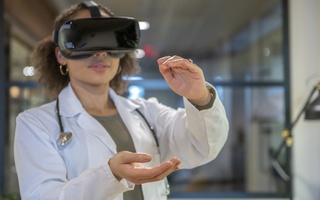We live in a unique time. Our generation has witnessed the change of millennia, many people remember the Year 2000 problem, solving which demanded the joint effort of almost the entire IT market. Today we are at the dawn of the 4th Industrial Revolution—a unique phenomenon that will change our world and affect nearly all fields of human activity, including most sectors of the economy.
A few years ago, our company created a division specializing in the study of megatrends—global trends that shape the future of the planet, preparations expected from market players, and fields where we should look for new business growth opportunities. From year to year, we publish relevant studies highlighting the following megatrends: accelerated urbanization, demographic changes, hyper-globalization, and accelerated innovation.
Let us talk today about the first of these megatrends and its impact on the economy as a whole.
Trend No.1 is accelerated urbanization. The world's population is projected to reach 8.5 billion by 2030. 97% of population growth will come from emerging economies, and most of those people will call their homes not countries but megacities. By 2025, more than half of the world's population—5 billion people—will live in cities, with Asian metropolises accounting for about 2.5 billion people.
As people move to cities, the latter grow, and the number of such megacities increases. In 1990, there were only ten cities with a population of over 10 million people, but by 2030 we will see 41 such megacities. On a global scale, the area of urbanized land may triple between 2000 and 2030.
Large cities contribute to economic growth. By 2025, urbanization will be key to the emergence of another 1.8 billion consumers in the global economy, 95% of whom are in emerging markets. It is projected that in 2025, consumers in emerging markets will spend $30 trillion, which is 2.5 times more than in 2010. Cities will become growth drivers - for example, by 2025, the GDP of the Chinese city of Tianjin will be comparable to the GDP of entire Sweden. Instead of entering the market of countries, businesses will be concerned about entering the market of each specific megacity.
As social attitudes change, women will have an increasing influence on the global economy, from increasing participation in global labor to economic wealth and expenditure drivers. In the US, it is estimated that in 2015 women controlled $14 trillion worth of capital and influenced 85 percent of all consumer purchases. The same trends will be observed in emerging markets.
It is estimated that in the next decade, about 1 billion women, mostly in developing countries, will become new economic actors as full-time employees or microentrepreneurs. Growing rates of urban migration, access to education, improved healthcare, mobile technology, and microcredit services will continue to fuel this trend.
However, at a time when the middle class in developing countries will be growing, the gap between the poor and the rich in developed countries will increase, and many consumers are forced to rely more on the value of goods than on their quality. While the 20th-century economy may be characterized by an increase of the middle class in the industrialized countries of Europe and the United States, the 21st-century economy will be defined by the growth of the middle class in developing countries, mainly in Asia, and especially in China and India.
The African continent, with its strong potential, abundant natural resources, and high population, is of particular interest to the business community. Today Africa is becoming one of the business development priorities for large enterprises. The countries of the Dark Continent follow the global trends of urban agglomeration and accelerated city growth: Africa today has almost four dozen million-plus cities, which have both labor force and potential consumers of goods and services. For example, the population of Lagos, Nigeria, has increased a hundredfold in the past 60 years, from 200,000 to almost 20 million! Today, Lagos is one of the ten largest cities in the world, and it is projected that by 2100 the population of this city will exceed the population of Germany, France, or Great Britain, reaching 85–100 million people! It is worth noting that by 2030, 32% of the African population will be under 30 years of age, and by 2035, Africa's working-age population will become the largest on the planet.
Globally, the influx of urban consumers will lead to new business models, change the ways of shopping, and increase the demand for customized services. 3D printing capabilities such as those promoted by HP will allow cities to respond to the growing and changing needs of their residents by printing anything on demand—it will be easier than relying on today's conventional supply chain. The printed goods would be used in construction, entertainment, shopping, education, and even in new kinds of food. 3D printing makes it possible, for example, to transform some assembled parts or units into one piece, and therefore simplify its manufacturing.
With each month, millions of people worldwide move to cities, creating a huge load on urban infrastructure and power grid and increasing the housing construction expenses. Homes, offices, and cities have to become smart and efficient. Smart urban development projects are booming to address this challenge. The number of Smart City initiatives has almost doubled in the last two years. As more and more people move to cities, the demand for housing and coworking offices is growing, and creating such infrastructure is a rising global trend.
What about Russia?
Most of the above urbanization trends are also observed in Russia.
The UN predicts that by 2050, 75% of Russia's population will live in cities. The same study says that by 2030 Moscow and St. Petersburg, as well as the existing 13 cities with million inhabitants and more, will remain the most densely populated areas in Russia. The number of cities with a population of 500 thousand to 1 million people will also rise.
Without the development of new smart urban management technologies, this urbanization boom may result in environmental, social, and economic problems. It is necessary to either invest in new infrastructure or improve the efficiency of existing systems to prevent possible threats.
Today, the concept of Smart City is being developed at the state level—in 2019, 23 regions of Russia were planned to send the approved summaries of regional Smart City projects to the Ministry of Construction. Housing and utilities, urban development, transport infrastructure are some of the urban economy sectors that will be digitized to meet the existing and upcoming urbanization challenges.
Modern technologies make the Internet truly ubiquitous. According to the study, in 2018, more than 75% of the population over 16 years of age in Russia were Internet users, and this number grows from year to year thanks to the older generation (55+). The Internet penetrates more and more remote settlements, contributing to the growth of online commerce. Trust in cashless payment is gradually growing among the population, and logistics companies ensure the delivery of products to consumers. It is worth noting that the continuously updated infrastructure of the Russian Post allows customers to receive their orders even in remote settlements. This, of course, has a positive impact on Russian e-commerce: its volume in 2018 reached 1.66 trillion rubles.
A business that understands where the demand for its products will rise, what demographic changes lie ahead, and how technologies will change our future, will always be one step ahead of competitors who live for the day.










